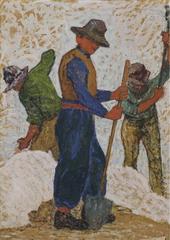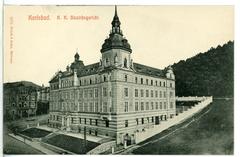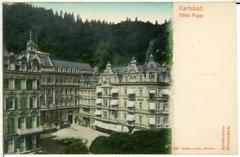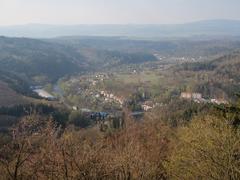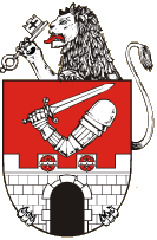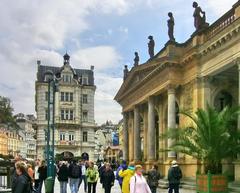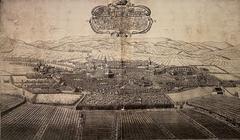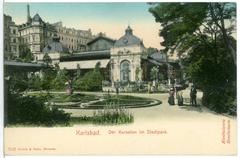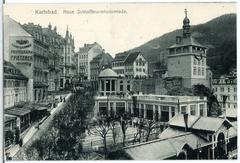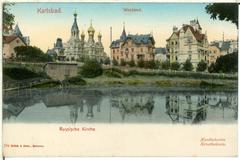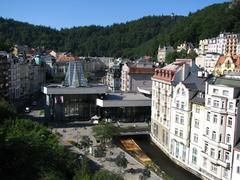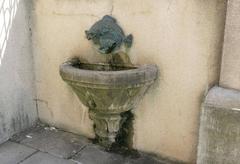
Visiting the Bust of Goethe in Karlovy Vary, Czech Republic: Complete Guide
Date: 04/07/2025
Introduction
Nestled in the scenic spa town of Karlovy Vary, the Bust of Johann Wolfgang von Goethe stands as an evocative tribute to one of Europe’s greatest literary and intellectual figures. Goethe visited Karlovy Vary thirteen times between 1785 and 1823, drawn by the town’s renowned mineral springs, picturesque landscape, and vibrant cultural scene. Today, the monument not only commemorates his enduring connection to the city but also invites visitors to explore the rich heritage of a destination celebrated for its cosmopolitan past and spa traditions. Located on Goethova stezka (Goethe’s Path), near iconic landmarks such as the Grandhotel Pupp and the Teplá River, the bust is an accessible, free-of-charge site, perfect for those interested in literature, history, and European culture (Karlovy Vary Official Tourism; Prague Now; Karlovy Vary History).
Table of Contents
- Introduction
- Goethe’s Connection to Karlovy Vary
- Origins and Artistic Significance of the Bust
- Visiting the Goethe Bust: Hours, Access, and Travel Tips
- Location and Nearby Attractions
- Practical Visitor Information
- Walking Route and Itinerary Suggestions
- Special Events and Cultural Context
- Frequently Asked Questions (FAQ)
- Conclusion and Recommendations
- Sources and Further Reading
Goethe’s Connection to Karlovy Vary
Johann Wolfgang von Goethe, the illustrious German poet and polymath, formed a deep connection with Karlovy Vary (Carlsbad) through his repeated visits. He first arrived in 1785 and returned twelve more times until 1823, seeking the therapeutic powers of the springs, engaging with European aristocracy, and drawing inspiration for his literary and scientific work. Goethe’s celebrated declaration, “I would like to live in three cities: Weimar, Carlsbad, and Rome,” underscores the significance of Karlovy Vary in his life (Prague Now).
During his stays, Goethe studied mineralogy and botany, participated in the town’s intellectual life, and experienced a late-life romance with Ulrike von Levetzow, inspiring some of his poetry. The town honors his legacy through the bust, Goethe’s Lookout (a neogothic tower), and the naming of local paths and landmarks (Wikipedia: Goethe’s Lookout).
Origins and Artistic Significance of the Bust
The Bust of Goethe was unveiled in 1883, sixty years after his final visit, as a symbol of the city’s appreciation for his influence. Crafted in the classic style of 19th-century commemorative sculpture, the bust captures Goethe’s dignified features atop a marble pedestal, harmonizing with the parkland surroundings. Although the sculptor’s name is not widely recognized, the artwork reflects the period’s reverence for intellectual achievement and enduring cultural legacy (Wikimedia Commons).
Originally installed in front of the Grandhotel Pupp, the bust was relocated to its current site along Goethe’s Path in 1952. Its placement encourages visitors to walk in Goethe’s footsteps, connecting the monument to the city’s tradition as a meeting ground for artists, scientists, and European elites (Karlovy Vary History).
Visiting the Goethe Bust: Hours, Access, and Travel Tips
Visiting Hours and Admission
- Open Access: The bust is located outdoors and is accessible year-round, 24 hours a day.
- Admission: Visiting the monument is entirely free; no tickets or reservations are required.
- Best Time to Visit: Spring and summer offer lush greenery, while autumn features vibrant foliage. Early morning or late afternoon provides optimal lighting for photography and a peaceful atmosphere.
Accessibility
- Pathway: The route is pedestrian-friendly and generally accessible for all ages. The final approach involves a gentle incline and narrower path, which may be challenging for some with mobility issues.
- Wheelchair Access: Most of Goethe’s Path is suitable for wheelchairs and strollers, but assistance may be required for the last stretch.
- Signage: Clear bilingual signs in Czech and English guide visitors from the city center and main bus stops to the monument.
Getting There
On Foot:
From the city center (Hot Spring/Colonnades), follow the Teplá River upstream, pass the Grandhotel Pupp, and ascend Goethova stezka (Goethe’s Path). The walk takes about 15–20 minutes and is well-marked (Karlovy Vary Official Tourism).
By Public Transport:
Take Bus No. 2 or 7 from “Tržnice” (Market) to “Richmond.” From there, it’s a short 500-meter walk up Goethe’s Path.
Parking:
Parking is available in the city center and near the Grandhotel Pupp.
Location and Nearby Attractions
Bust Location:
Situated in the southern part of Karlovy Vary, the bust stands along Goethe’s Path in a tranquil, wooded area near the Teplá River and the Grandhotel Pupp. The site is easily integrated into a walking tour of the historic spa quarter (Wanderlog; Karlovy Vary Spa Forests).
Nearby Attractions:
- Grandhotel Pupp: Iconic luxury hotel, a short walk from the bust.
- Karlovy Vary Art Gallery: Features regional and international art, located near the Richmond bus stop.
- Spa Colonnades (Mill, Market, Hot Spring): Historic covered walkways with mineral springs.
- Diana Observation Tower: Panoramic city views, accessible by funicular or via forest trails.
- Deer Leap (Jelení skok): Scenic viewpoint with a local legend.
- St. Mary Magdalene Church: A baroque landmark near the spa district.
Practical Visitor Information
- Restrooms: Available near Grandhotel Pupp and in the city center.
- Cafés and Refreshments: Numerous options along the Teplá River and near the main colonnades.
- Tourist Information: The Karlovy Vary Tourist Information Centre provides maps, brochures, and assistance in multiple languages.
- Safety: The area is safe during daylight hours. Visitors are asked to respect the monument and its surroundings.
Walking Route and Itinerary Suggestions
Sample One-Day Itinerary Including Goethe’s Bust:
| Time | Activity |
|---|---|
| 09:00–10:30 | Explore Mill Colonnade, Market Colonnade, and sample mineral springs |
| 10:30–11:00 | Visit St. Mary Magdalene Church and stroll down Stara Louka |
| 11:00–12:00 | Walk into spa forests, visit the Bust of Goethe |
| 12:00–13:00 | Continue to Diana Observation Tower and Deer Leap |
| 13:00–14:00 | Lunch at Postal Court Restaurant or picnic in the spa forest |
| 14:00–15:00 | Return to town, visit Jan Becher Museum or relax at a café |
| 15:00–17:00 | Optional: Visit Moser Glass Museum, shop for souvenirs, or enjoy spa treatments |
Tips:
- The spa forest trails are clearly marked with colored signs and maps at intersections.
- Wear comfortable walking shoes, especially if exploring forested areas.
- Bring water and snacks if planning an extended walk.
Special Events and Cultural Context
- Karlovy Vary International Film Festival: Held annually in July, the festival draws international crowds. The spa forests and Goethe’s Path provide a peaceful retreat amidst the festivities (Salt in Our Hair).
- Seasonal Highlights: Spring and summer bring lush foliage, while autumn offers brilliant colors. Horse-drawn carriage rides and local festivals are also popular in peak season (My Wanderlust).
- Cultural Engagement: The bust is occasionally the site for literary readings, art exhibitions, and community events, especially during local festivals.
Frequently Asked Questions (FAQ)
Q: Is there an entrance fee to visit the Bust of Goethe?
A: No, visiting the monument is free of charge.
Q: What are the visiting hours?
A: The bust is accessible year-round, 24/7, though daylight visits are recommended.
Q: Are guided tours available?
A: Many Karlovy Vary walking tours include the bust as part of their itinerary (Karlovy Vary Sightseeing Tours).
Q: Is the site wheelchair accessible?
A: Most of the path is accessible, but the final approach may require assistance.
Q: How do I reach the bust from the town center?
A: Follow the Teplá River upstream to the Grandhotel Pupp, then ascend Goethe’s Path.
Q: What other attractions are nearby?
A: Grandhotel Pupp, Karlovy Vary Art Gallery, spa colonnades, Diana Observation Tower, and Deer Leap are all close by.
Conclusion and Recommendations
The Bust of Johann Wolfgang von Goethe in Karlovy Vary is more than a monument; it is a gateway to the city’s rich literary and spa culture. Freely accessible year-round and nestled in beautiful surroundings, it provides a peaceful setting for reflection and connects visitors to the legacy of one of Europe’s greatest thinkers. Whether included in a guided tour or explored independently, the bust enhances any visit to Karlovy Vary’s historic core.
To enrich your experience, download the Audiala app for guided audio tours, consult local tourism websites for event updates, and follow us on social media for inspiration and practical tips. Embrace the opportunity to walk in Goethe’s footsteps and discover the timeless charm of Karlovy Vary.
Sources and Further Reading
- Karlovy Vary Official Tourism, Bust of Johann Wolfgang von Goethe
- Karlovy Vary History
- Prague Now, Day Trip to Karlovy Vary Spa
- Museum of Wander, Kaiserbad Karlsbad History
- Wild East Blog, Karlovy Vary Czech Republic Guide
- Wanderlog, Socha Goetheho Karlovy Vary
- Wikimedia Commons, Bust of Goethe in Karlovy Vary
- Salt in Our Hair, Karlovy Vary Guide
- My Wanderlust, What to do in Karlovy Vary
- Karlovy Vary Sightseeing Tours






